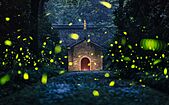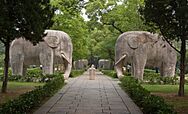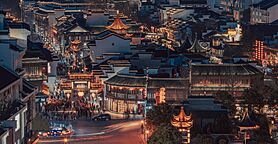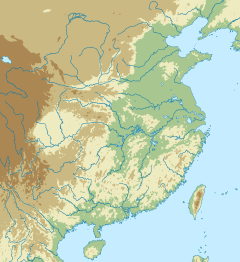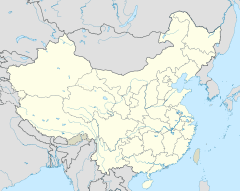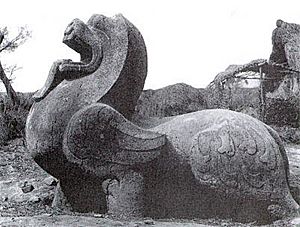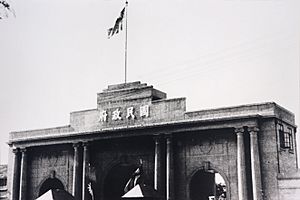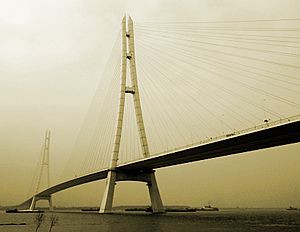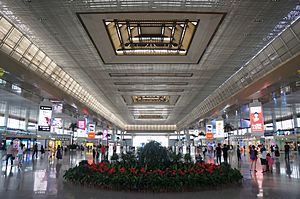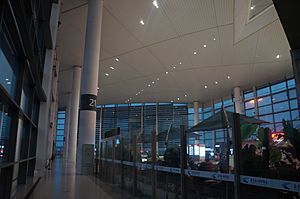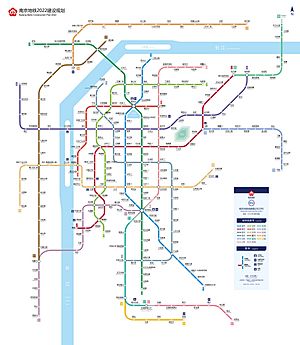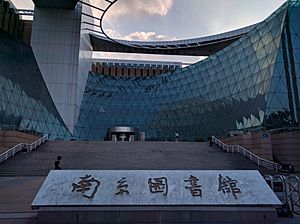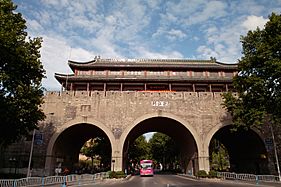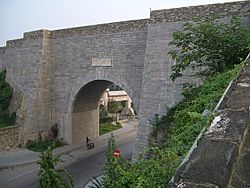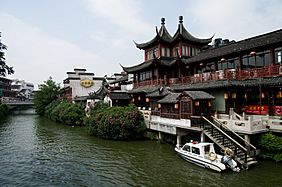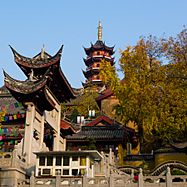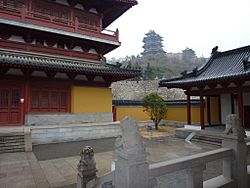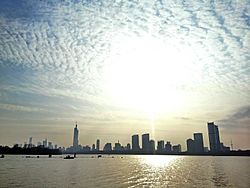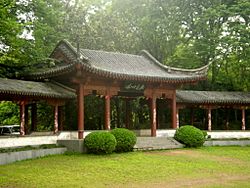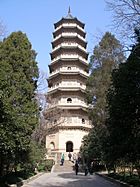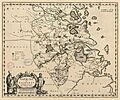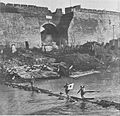Nanjing facts for kids
Quick facts for kids
Nanjing
南京市
Nanking, Nan-ching
|
|
|---|---|
|
Prefecture-level and sub-provincial city
|
|
|
Nanjing Skyline
Linggu Temple
Ming Xiaoling Mausoleum
Confucius Temple
|
|
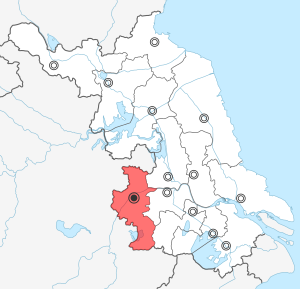
Location of Nanjing City jurisdiction in Jiangsu
|
|
| Country | China |
| Province | Jiangsu |
| County-level | 11 |
| Township-level | 129 |
| Settled | unknown (Yecheng, 495 BCE. Jinling City, 333 BCE) |
| Municipal seat | Xuanwu District |
| Government | |
| • Type | Sub-provincial city |
| • Body | Nanjing Municipal People's Congress |
| Area | |
| • Prefecture-level and sub-provincial city | 6,587 km2 (2,543 sq mi) |
| • Urban | 1,398.69 km2 (540.04 sq mi) |
| Elevation | 20 m (50 ft) |
| Population
(2020 census)
|
|
| • Prefecture-level and sub-provincial city | 9,314,685 |
| • Density | 1,414.10/km2 (3,662.51/sq mi) |
| • Urban | 9,314,685 |
| • Metro | 9,648,136 |
| Demonym(s) | Nankinese or Nanjinger |
| GDP | |
| • Prefecture-level and sub-provincial city | CN¥ 1.636 trillion US$ 253.6 billion |
| • Per capita | CN¥ 175,587 US$ 27,223 |
| Time zone | UTC+08:00 (China Standard) |
| Postal code |
210000–211300
|
| Area code(s) | 25 |
| ISO 3166 code | CN-JS-01 |
| Human Development Index | 0.859 (very high) |
| Website | City of Nanjing |
|
Deodar Cedar (Cedrus deodara), Platanus × hispanica Méi (Prunus mume) |
|
| Nanjing | |||||||||||||||||||||||||||||||||
|---|---|---|---|---|---|---|---|---|---|---|---|---|---|---|---|---|---|---|---|---|---|---|---|---|---|---|---|---|---|---|---|---|---|

"Nanjing" in Chinese characters
|
|||||||||||||||||||||||||||||||||
| Chinese | 南京 | ||||||||||||||||||||||||||||||||
| Postal | Nanking | ||||||||||||||||||||||||||||||||
| Literal meaning | "Southern Capital" | ||||||||||||||||||||||||||||||||
|
|||||||||||||||||||||||||||||||||
Nanjing is a very important city in East China. It is the capital of Jiangsu province. The city is located in the southwestern part of the province. It has 11 districts and covers about 6,600 square kilometers. As of 2021, about 9.4 million people live there.
Nanjing is in the Yangtze River Delta region. It has a special place in Chinese history and culture. For a long time, from the 3rd century to 1949, it was the capital for many different Chinese dynasties and governments. This means it has always been a major center for culture, education, research, politics, economy, and tourism. It even has one of the world's largest inland ports.
Nanjing is also one of China's 15 sub-provincial cities. This means it has a lot of freedom in how it is run and how it manages its money, almost like a province. The city has won awards like the 2008 Habitat Scroll of Honor of China. It is also considered a "Beta" global city, like Chongqing, Hangzhou, and Tianjin. It is ranked among the top 100 cities in the world for finance.
In 2021, Nanjing had 68 universities and colleges. Many of these are top-ranked schools. For example, Nanjing University is one of the world's top 20 universities for science research. Nanjing has the third-highest number of top universities in China, after Beijing and Shanghai. It also has the most college students compared to its total population among large cities in China. Nanjing is a global leader in scientific research. In 2023, it was ranked second in the world for research in earth and environmental sciences. It was also ranked third globally for research in chemistry.
Nanjing has been one of China's most important cities for over a thousand years. It is known as one of the Four Great Ancient Capitals of China. It has been one of the world's largest cities at different times. Even with many wars and disasters, it has often been a peaceful and wealthy place. Nanjing was the capital for several important Chinese dynasties and governments. These include Eastern Wu (229–280), the Eastern Jin dynasty (317–589), and the Ming dynasty (1368–1421). It was also the capital of the Republic of China from 1927 to 1949.
The city also served as the capital for the rebel Taiping Heavenly Kingdom (1853–64). Later, during the Second Sino-Japanese War, it was the seat of a Japanese-controlled government (1940–45). Nanjing suffered greatly during these conflicts. A very sad event called the Nanjing Massacre happened there from late 1937 to early 1938.
Since the People's Republic of China was formed, Nanjing has been the capital city of Jiangsu province. It has many important historical sites. These include the Presidential Palace, Sun Yat-sen Mausoleum, and Ming Xiaoling Mausoleum. Nanjing is also famous for its beautiful natural spots like Qinhuai River, Xuanwu Lake, and Purple Mountain. Important cultural places are Nanjing Library, Nanjing Museum, and Jiangsu Art Museum.
Contents
- Understanding Nanjing's Names
- A Look at Nanjing's History
- Nanjing's Geography and Environment
- People and Population
- Nanjing's Economy
- Getting Around Nanjing
- Culture and Arts in Nanjing
- Art and Galleries
- Festivals and Celebrations
- Libraries and Museums
- Theater and Performances
- Nightlife and Entertainment
- Food and Local Dishes
- Sports and Recreation
- Architecture and Buildings
- City Symbols
- Folklore and Traditions
- Literature and Writing
- Film and Television
- Music and Dance
- Photography
- Folk Crafts
- Education in Nanjing
- Nanjing's Sister Cities
- Famous People from Nanjing
- Images for kids
- See also
Understanding Nanjing's Names
Nanjing has had many names throughout history. Some old names are now used for districts in the city.
The city was first known as Yuecheng and Jinling (meaning "Golden Hill") during the Warring States Era. Later, during the Eastern Wu dynasty, it was called Jianye (meaning "build an empire"). It became a Chinese capital for the first time during the Jin dynasty and was renamed Jiankang.
The name Nanjing means "southern capital." This name was officially given to the city during the Ming dynasty, about 600 years ago. In English, the spelling Nanking was used for a long time. But in the 1980s, the spelling "Nanjing" became the standard.
During the Qing dynasty, the city was called Jiangning. The first part of this name, jiang, refers to the Yangtze River. The second part, ning, means "peace." When it was the capital of the Republic of China (1912–49), people used "Jing" as a short form for Nanjing.
A Look at Nanjing's History
Nanjing has a very long and rich history, going back thousands of years.
Early Beginnings and First Settlements
Archaeologists have found signs that people lived in the Nanjing area more than 500,000 years ago. About 7,000 years ago, there was farming here. Primitive villages from the Stone Age have been found in the Jiangning district.
Around 4,000 years ago, many Bronze Age settlements appeared along the Qinhuai River. These were the first cities in Nanjing. In 571 BC, the State of Chu built Tangyi in Liuhe. This is the oldest administrative area in Nanjing. In 495 BC, a fort called Yecheng was built in the Nanjing area.
Later, in 333 BC, the Chu state built Jinling Yi in the western part of Nanjing. This is where the name Jinling comes from. In 210 BC, the First Emperor of Qin changed Jinling City to Moling. The area was part of different prefectures in the Qin and Han dynasties. Nanjing was also the capital of Danyang Prefecture and Yangzhou for about 400 years.
Nanjing as a Capital City: The Six Dynasties Period
Towards the end of the Eastern Han dynasty, a leader named Sun Quan moved his office to Moling in 211 AD. He built the Stone City and renamed Moling to Jianye. Jianye became the capital of the Eastern Wu dynasty in 229 AD. This was the start of Nanjing's history as a state capital.
When the Western Jin dynasty took over in 280 AD, Jianye was a busy center for trade, culture, and politics. Later, northern China faced many problems. So, many rich families moved to Jianye for safety. In 318 AD, a prince named Sima Rui became emperor in Jiankang (the new name for Jianye). He started the Eastern Jin dynasty. This was the first time a Chinese capital moved from the north to the south.
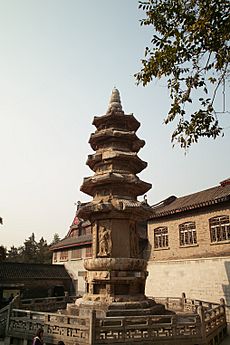
Jiankang was the main city in the south for over 250 years. Even when China was divided into Northern and Southern dynasties, Jiankang remained the capital. It was the capital for the Southern dynasties of Liu Song, Southern Qi, Liang, and Chen. During this time, Jiankang was a major international center in East Asia. Historical records show it had over 1.4 million residents.
Many stone sculptures from this time, found at tombs of important people, still exist today. The best-preserved one is at the Tomb of Xiao Xiu. The "Six Dynasties" is a term for the six Chinese dynasties that had their capitals in Jiankang.
Challenges and Rebirth
When the Sui dynasty reunited China, they almost completely destroyed Nanjing, turning it into a small town. It was later renamed Shengzhou during the Tang dynasty and slowly rebuilt.
It became a capital again during the Southern Tang (937–976) and was called Jinling. In the Song dynasty, it was renamed Jiangning and then Jiankang. During the Song dynasty, Nanjing's textile industry grew strong.
The Mongols later conquered China and ruled as the Yuan dynasty. Nanjing's textile industry continued to grow. A traveler named Odoric of Pordenone said that Nanjing had 360 stone bridges, which were more beautiful than any others in the world.
Nanjing as the Southern Capital of the Ming Dynasty
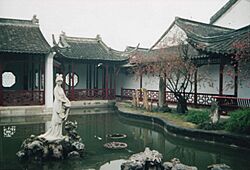
After Zhu Yuanzhang (the Hongwu Emperor) overthrew the Yuan dynasty and started the Ming dynasty, he made Nanjing his capital in 1368. He renamed the city Yingtian. The Hongwu Emperor built a huge city wall around Yingtian, which was 48 kilometers long. It took 200,000 workers 21 years to build this wall. Today, this wall is still in good condition and is one of the longest surviving city walls in China.
Nanjing was likely the largest city in the world from 1358 to 1425, with a population of 487,000 in 1400. The next emperor, the Yongle Emperor, moved the main capital to Beijing in 1421. However, Nanjing kept its special status as the "southern capital."
Other famous Ming-era buildings in Nanjing include the Ming Xiaoling Mausoleum and the Porcelain Tower. Sadly, the Porcelain Tower was destroyed in the 19th century.
Nanjing was a global center during the early Ming dynasty. It was the home of Admiral Zheng He, who led famous sea voyages across the Pacific and Indian Oceans. Foreign leaders also visited the city.
Nanjing During the Qing Dynasty and Taiping Rebellion
Under the Qing dynasty (1645 to 1911), Nanjing was called Jiangning again. It was an important administrative center. The Treaty of Nanking, which ended the First Opium War, was signed in the city's harbor in 1842.
In the mid-19th century, Nanjing became the capital of the rebel Taiping Heavenly Kingdom. They called it Tianjing (meaning "Heavenly Capital"). The rebellion destroyed many old Ming buildings, including the Porcelain Tower. When Qing forces took back the city in 1864, there was a huge conflict.
Nanjing as Capital of the Republic of China
The Xinhai Revolution led to the founding of the Republic of China in January 1912. Nanjing was chosen as its first capital. However, the capital was later moved to Beijing.
In 1927, the Kuomintang (KMT) party, led by Generalissimo Chiang Kai-shek, made Nanjing the capital of the Republic of China again. This period is known as the "Nanjing Decade." During this time, Nanjing grew a lot and became one of China's most modern cities. Many new government buildings and public services were built.
In 1937, Japan invaded China, starting the Second Sino-Japanese War. Japanese troops occupied Nanjing in December 1937. During this time, the city experienced the terrible Nanjing Massacre. A memorial hall was built in 1985 to remember this event.
The Chinese government moved to Chongqing. In 1940, a Japanese-supported government was set up in Nanjing. After Japan surrendered in 1946, the KMT government moved back to Nanjing.
Nanjing in Modern China
In April 1949, Communist forces captured Nanjing. The KMT government then moved to Taiwan. After the People's Republic of China was formed in October 1949, Nanjing became the capital of Jiangsu province, which it remains today.
Nanjing's Geography and Environment
Nanjing covers about 6,598 square kilometers. It is located in the lower part of the Yangtze River, in the Yangtze River Delta. This is one of China's biggest economic areas. The Yangtze River flows past the city. Nanjing is about 270 kilometers west-northwest of Shanghai.
Nanjing shares borders with several other cities. To its east are Zhenjiang and Changzhou. To its west, it borders five cities in Anhui province.
Climate and Weather
Nanjing has a humid subtropical climate. This means it has four clear seasons. Summers are very hot and humid. Winters are cold and damp. Spring and autumn are pleasant. Nanjing is sometimes called one of the "Three Furnaces" along the Yangtze River because of its hot summers.
The average temperature in January is about 3.1°C (37.6°F). The average in July is about 28.4°C (83.1°F). Nanjing gets about 1,144 millimeters (45 inches) of rain each year. Typhoons are rare but can happen in late summer or early autumn.
Natural Resources
Nanjing has many natural resources, including over 40 types of minerals. Its iron and sulfur reserves make up 40% of Jiangsu province's total. Nanjing also has a lot of water from the Yangtze River and groundwater. There are also several natural hot springs, like Tangshan Hot Spring.
Xuanwu Lake and Mochou Lake are beautiful lakes in the city center. Purple Mountain is covered with forests and has many historical sites.
Environmental Concerns
In December 2013, a thick smog covered much of eastern China, including Nanjing. This pollution was caused by a lack of wind, car exhaust, and coal heating systems. Nanjing experienced "severely polluted" air for five days.
Soil and Water Resources
Nanjing has two main types of soil: yellow-brown soil in the north and red soil in the south. There is also cultivated soil, mainly paddy soil from farming.
The Yangtze River flows through Nanjing for about 93 kilometers. The Qinhuai River also flows through the city and is known as Nanjing's "mother river." The city's water area makes up about 11% of its total area. Nanjing also has plenty of groundwater.
The Port of Nanjing is China's largest inland port. It handles a huge amount of cargo each year. It is the biggest container port along the Yangtze River. Large ocean ships can reach Nanjing Port directly.
Animal and Plant Life
Nanjing is rich in plant life, with many different types of plants. It has coniferous forests, broad-leaved forests, bamboo forests, and more. There are 1,061 species of vascular plants, which is about 64.7% of all plants in Jiangsu Province. Some rare and endangered plants are protected here. The city's forest cover is 27.1%.
Nanjing is also home to many wild animals. There are 795 insect species, 99 fish species, and 327 land vertebrates. This includes 243 bird species and 47 mammal species. Nine species are under national first-level protection, like the Oriental White Crane.
Yangtze River Crossings
In the 1960s, the first Nanjing Yangtze River Bridge was built. It was the only bridge crossing the lower Yangtze River at that time. This bridge was a symbol of modern China because it was built by the Chinese themselves. Since then, four more bridges and four tunnels have been built across the Yangtze River in Nanjing.
Mineral Resources
Nanjing has many mineral resources. There are 41 types of minerals, including iron, copper, lead, zinc, and sulfur. Nanjing has the largest reserves of strontium ore in East Asia. Its copper and lead-zinc reserves make up over 90% of the province's total.
People and Population
In 2010, Nanjing's total population was about 8 million people. By 2011, it was estimated to be 8.11 million. The city's population is mostly Han nationality (98.56%). There are also 50 other official ethnic groups. The largest minority group is the Hui people.
Languages Spoken
Most people in Nanjing speak Nanjing Mandarin. In some southern parts, Wu Chinese is spoken. Nanjing dialect was once the official language of China for a long time. Mandarin Chinese is now widely spoken across China.
Religions in Nanjing
Nanjing has four main religions: Buddhism, Taoism, Christianity, and Islam. Nanjing was one of the first places in China where Buddhist culture spread. It was a major center for Buddhism. The Jinling Carved Scriptures, which publishes Buddhist texts, is a world heritage site.
Taoism also has a long history in Nanjing. Christianity began to spread here over 400 years ago. Nanjing is an important center for Christianity in China. It has two seminaries and the Amity Foundation, which prints Bibles. Nanjing is also known as a birthplace for the Islamic "Renaissance" in China.
Nanjing's Economy

Today, Nanjing's economy is mostly based on service industries. These include finance, culture, and tourism, which are the top three. Other important industries are information technology, energy saving, environmental protection, and smart equipment manufacturing.
Many large companies are based in Nanjing, like Suning Commerce and Yurun. Big state-owned companies include Panda Electronics and Yangzi Petrochemical. Many international companies like Siemens, Ericsson, and Volkswagen have also set up businesses here. Companies like Ford and IBM have research centers in Nanjing.
Nanjing is a hub for industrial technology research. It has many research centers, especially in electronics, information technology, software, and new materials. In 2013, Nanjing's GDP (Gross Domestic Product) was 801 billion RMB. This shows how much the city's economy has grown. In 2019, Nanjing's GDP was 1,403 billion yuan, ranking 11th in China.
Farming and Fishing
Nanjing is an important area for farming and growing grain in China. Main crops include rice, cotton, and tea. Because of the fertile water around the Yangtze River, it is also a major freshwater fishing area.
Manufacturing and Industry
In 2019, Nanjing's industries grew by 6.9%. Important industries include electronics, electrical machinery, steel, medicine, and general equipment. Many private companies and foreign companies have seen strong growth.
Service Industries
Nanjing is a key financial and business center. The financial industry is a very important part of Nanjing's economy. In 2018, Nanjing's financial industry ranked fourth in China, after Beijing, Shanghai, and Shenzhen.
Nanjing is also a major center for software and information services. It is China's only pilot city for science and technology reform. In 2019, Nanjing ranked first among Chinese cities for service outsourcing. The software and information service industry in Nanjing had a revenue of 450 billion yuan in 2018.
The convention and exhibition industry is also important. Nanjing is a top city for hosting international conferences and exhibitions.
Getting Around Nanjing
Nanjing is a major transportation hub in eastern China. It has a complete system for land, water, and air travel. Public transport is very popular for most people. Nanjing has four bridges and two tunnels across the Yangtze River, connecting different parts of the city.
Train Travel
Nanjing is a key railway hub in eastern China. It connects major railway lines like Beijing-Shanghai and Nanjing-Xi'an. Nanjing is also part of China's high-speed railway network.
The main train stations are Nanjing Railway Station and Nanjing South Railway Station. Nanjing South Railway Station is one of the largest high-speed railway stations in Asia.
Air Travel
Nanjing's airport, Lukou International Airport (NKG), handles both national and international flights. In 2013, it served over 15 million passengers. The airport has 85 routes to places like Japan, Korea, and the United States. A highway connects the airport directly to the city center.
Shipping and Ports
Nanjing Port is a very important port in China. It is a major hub for moving goods between rivers and the sea. It is the deepest inland international deep-water seaport. The port has 64 berths, including 16 for very large ships.
Roads and Highways
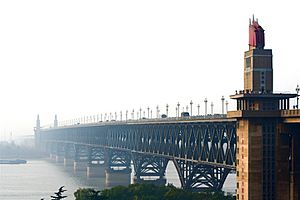
Nanjing has a great road network, with over 60 national and provincial highways. These connect Nanjing to all parts of China. Major highways link Nanjing to Shanghai, Hefei, and Hangzhou. Inside the city, there are 230 kilometers of highways. The main roads in Nanjing are Zhongshan Road and Hanzhong Road.
Public Transportation
Nanjing has a good public transport system with buses, taxis, and a metro. The bus network has over 370 routes. The Nanjing Metro system has 12 lines and 208 stations, covering 449 kilometers. Nanjing plans to have a 17-line metro and light-rail system by 2030. This will help reduce traffic.
Nanjing's first subway opened in 2005. It was the sixth city in mainland China to have a subway. As of 2019, the subway carries over 3.4 million passengers daily. Nanjing also has two tram lines.
Culture and Arts in Nanjing
Nanjing has always been a cultural center in China. Poets and thinkers gathered here. During the Ming and Qing dynasties, it was a major center for official exams. Today, Nanjing is known as a "city of culture" and a pleasant place to live.
Art and Galleries
Some of China's top art groups are based in Nanjing, like the Qianxian Dance Company. The Jiangsu Art Gallery is the largest gallery in Jiangsu Province. Nanjing has 14 cultural centers, 15 public libraries, and 132 movie theaters. There are also 87 museums, including the Nanjing Museum, which has 400,000 items.
Nanjing is famous for Chinese painting and calligraphy. Many famous artists have lived and worked here. The "Eight Masters of Nanjing" created the Jinling School of Painting.
Festivals and Celebrations
Many traditional festivals were celebrated in Nanjing long ago, but most are not celebrated today. Instead, Nanjing hosts many events for tourists. The annual International Plum Blossom Festival at Plum Blossom Hill is very popular. Other events include the Nanjing Baima Peach Blossom Festival.
Libraries and Museums
Nanjing Library, founded in 1907, is the third-largest library in China. It has over 10 million books. Nanjing University Library is also one of the largest university libraries in China.
Nanjing has some of China's oldest and best museums. The Nanjing Museum has a huge collection of Ming and Qing imperial porcelain. Other museums include the City Museum of Nanjing, the China Modern History Museum, and the Nanjing Massacre Memorial Hall.
Theater and Performances
Jiangsu Province Kun Opera is one of the best places to see Kunqu, China's oldest stage art. Nanjing also has professional opera groups for other Chinese opera styles. Most major theaters in Nanjing are used for many different events, like concerts and movies.
Xiqu is traditional Chinese drama. Peking opera has a long history in Nanjing. Kunqu Opera is a very old and important Chinese art form. Nanjing also has modern drama and local folk arts like Southern Crosstalk.
Nightlife and Entertainment
Nanjing's nightlife traditionally centered around Nanjing Fuzimiao (Confucius Temple) along the Qinhuai River. This area had night markets, restaurants, and pubs. Boating on the river at night was a popular activity.
Today, nightlife is more varied. There are shopping malls open late in the Xinjiekou area. The "Nanjing 1912" district has restaurants, pubs, and dance clubs. Many new nightlife spots have opened in Catherine Park and shopping malls.
Food and Local Dishes
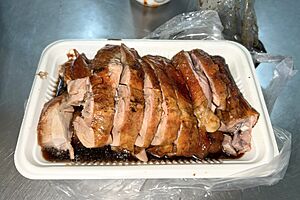
Nanjing's local food is called Jinling cuisine. It is part of Jiangsu cuisine. Jinling cuisine is known for being carefully prepared, fresh, and seasonal. Its duck and goose dishes are very famous. Many local favorite dishes use duck, like Nanjing salted duck and duck blood and vermicelli soup.
Nanjing people are sometimes called "radishes" because they love to eat wild vegetables. They have special dishes for different seasons and festivals.
Sports and Recreation
Nanjing is where modern Chinese sports began. The first National Games in Chinese history were held here in 1910. Nanjing has played a big role in China's Olympic history.
Nanjing has many professional sports teams. The city has two major sports centers: Wutaishan Sports Center and Nanjing Olympic Sports Center. These centers have stadiums, gyms, and swimming pools. The Nanjing Olympic Sports Center can seat 60,000 spectators.
Nanjing hosted the 10th National Games of PRC in 2005. In 2014, it hosted the 2nd Summer Youth Olympic Games. This was the first time China hosted the Youth Olympic Games.
Architecture and Buildings
Nanjing is famous for its many different types of buildings. These include structures from ancient dynasties, the Republic of China era, and modern times.
Buildings Inside the City Wall
- City Wall of Nanjing
- Zhonghua Gate
- Fuzimiao (Confucius Temple) and Qinhuai River
- Jiangnan Examination Hall
- Zhan Garden
- Ming Palace
- Jiming Temple
- Drum Tower of Nanjing
- Chaotian Palace
- Stone City
- Yuejiang Tower
- Jinghai Temple
Buildings Outside the City Wall
- Purple Mountain Scenic Area
- Ming Xiaoling Mausoleum
- Linggu Temple
- Xuanwu Lake
- Qixia Temple
- The Porcelain Pagoda of Nanjing (restored)
- Mochou Lake
- Yangshan Quarry
City Symbols
- City Tree: Cedar
- City Flower: Prunus mume (Plum Blossom)
- Tourist Symbol: Long Pan Tiger Standing (meaning a place of great power and importance)
Folklore and Traditions
Nanjing has many traditional folk activities. These include Chinese New Year greetings, hanging Spring Festival couplets, and eating special foods like rice cakes. People also celebrate the God of Wealth, climb the city wall, and sweep tombs during Qingming Festival. Other traditions include dragon boat races, eating moon cakes, and enjoying the moon during the Mid-Autumn Festival.
Literature and Writing
Nanjing is famous for its history in literature. The first "Literature Museum" in Chinese history was here. Many important literary works were created in Nanjing. Famous novels like "A Dream of Red Mansions" and "The Scholars" are connected to Nanjing.
Many modern writers like Lu Xun and Pearl Buck (who won the Nobel Prize for Literature) have strong ties to Nanjing.
Film and Television
Nanjing has been a popular place for filming movies and TV shows. The 1993 TV show "Legend of the New White Lady" was filmed at Jiming Temple. Movies like "The Founding of the People's Republic" and "Jinling Thirteen Hairpins" were also shot in Nanjing.
Music and Dance
Jinling Qin School is an important style of Chinese Guqin (a stringed instrument) music that started in Nanjing. It is a World Intangible Cultural Heritage. The famous folk song "Jasmine Flower" came from Nanjing. Nanjing also hosts music festivals like the Nanjing Forest Music Carnival.
Traditional folk dances in Nanjing include Luoshan Dragon and Dongba Dama Lantern. Many of these dances are recognized as intangible cultural heritage. Nanjing also has a special art school for children, the Nanjing Art Primary School, which is famous for its performances.
Photography
Nanjing is a great place for photography. Many award-winning photos have been taken here. The Nanjing Photographic Association holds many exhibitions and competitions. In 2022, a photography competition called "A Decade of Nanjing" showed changes in the city through the eyes of foreigners.
Folk Crafts
Nanjing has many traditional folk crafts. These include brocade (a rich fabric), paper-cutting, lantern making, gold leaf, and wood carving. Nanjing has 4 world intangible cultural heritage projects, including Nanjing cloud brocade weaving and Chinese paper-cutting.
Education in Nanjing

Nanjing has been a center for education in southern China for over 1,700 years. By 2021, it had 68 universities and colleges. This includes 13 "double-first-class" universities, which are top-tier schools in China. Nanjing has the third-highest number of top universities in China, after Beijing and Shanghai.
Nanjing University is one of the best universities in China and is ranked among the world's top 20 universities for science research. Southeast University is also very famous, especially for architecture and engineering. Many universities in Nanjing have moved their main campuses to the Xianlin University City.
Some other important universities in Nanjing are:
- Hohai University
- Nanjing Normal University
- Nanjing University of Aeronautics and Astronautics
- Nanjing University of Science and Technology
- China Pharmaceutical University
- Nanjing Medical University
Some notable high schools in Nanjing include Jinling High School and Nanjing Foreign Language School.
Nanjing's Sister Cities
Nanjing has many sister city relationships with cities around the world. These partnerships help promote cultural exchange and friendship.
 Akko, Israel
Akko, Israel Bandar Seri Begawan, Brunei
Bandar Seri Begawan, Brunei Barranquilla, Colombia
Barranquilla, Colombia Biên Hòa, Vietnam
Biên Hòa, Vietnam Birmingham, United Kingdom
Birmingham, United Kingdom Bloemfontein, South Africa
Bloemfontein, South Africa City of San Marino, San Marino (2021)
City of San Marino, San Marino (2021) Concepción, Chile
Concepción, Chile Daejeon, South Korea
Daejeon, South Korea Eindhoven, Netherlands
Eindhoven, Netherlands Florence, Italy
Florence, Italy Katmandu, Nepal
Katmandu, Nepal Leipzig, Germany
Leipzig, Germany Limassol, Cyprus
Limassol, Cyprus London, Canada
London, Canada Malacca City, Malaysia
Malacca City, Malaysia Melbourne, Australia
Melbourne, Australia Mexicali, Mexico
Mexicali, Mexico Mogilev, Belarus
Mogilev, Belarus Nagoya, Japan
Nagoya, Japan Perth, Australia
Perth, Australia Semarang, Indonesia
Semarang, Indonesia Shiraz, Iran
Shiraz, Iran Siem Reap, Cambodia
Siem Reap, Cambodia St. Louis, United States
St. Louis, United States Windhoek, Namibia
Windhoek, Namibia
The relationship with Nagoya, Japan, was paused in 2012 due to comments about the Nanjing Massacre. However, non-government relations have since been restored.
Famous People from Nanjing
- Xueqin Cao (1715 or 1724 - 1763 or 1764), a famous writer who wrote Dream of the Red Chamber.
- Anhua Gao (born 1949), a Chinese-British author.
- Pu Shu (born 1973), a Chinese singer-songwriter.
- Mei Ting (born 1975), a Chinese actress.
- Ni Ni (born 1988), a Chinese actress.
- Wu Lei (born 1991), a Chinese football player.
- Zhang Zetian (born 1993), a young Chinese female billionaire.
- Lu Keran (born 1995), a Chinese singer and dancer.
Images for kids
-
Purple Mountain and Xuanwu Lake.
-
Nanjing City Wall near Xuanwumen Gate.
See also
 In Spanish: Nankín para niños
In Spanish: Nankín para niños



